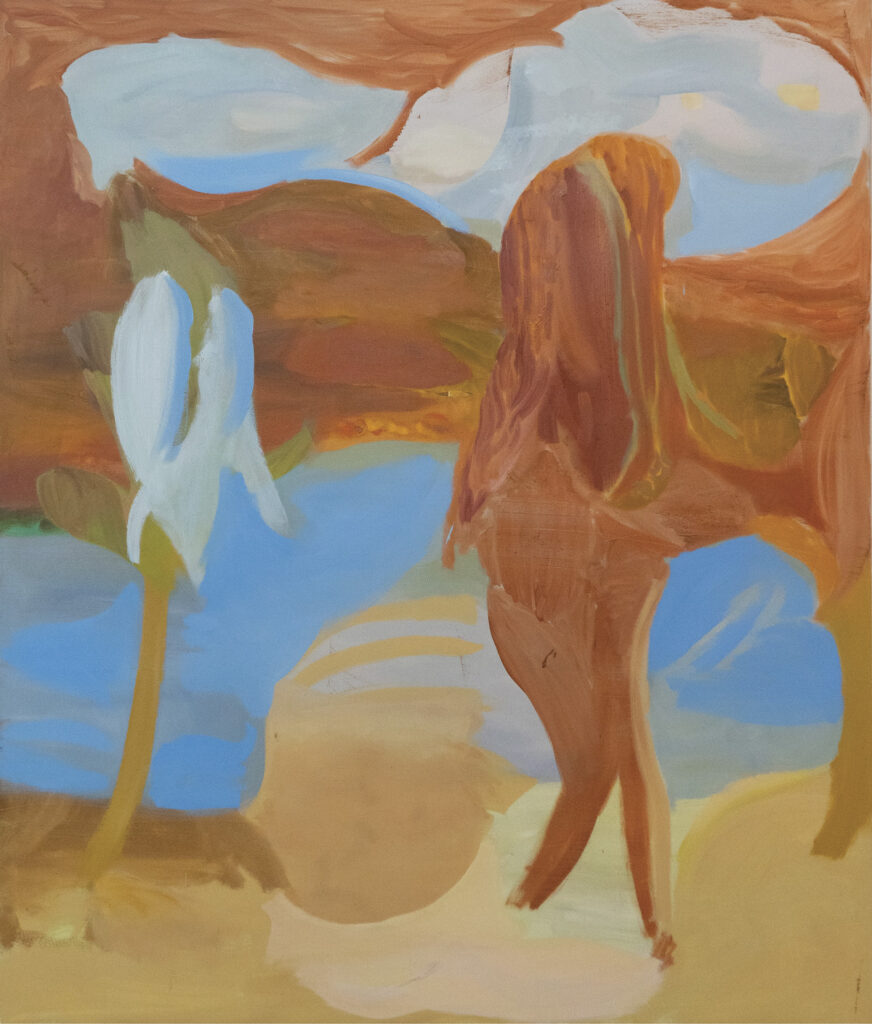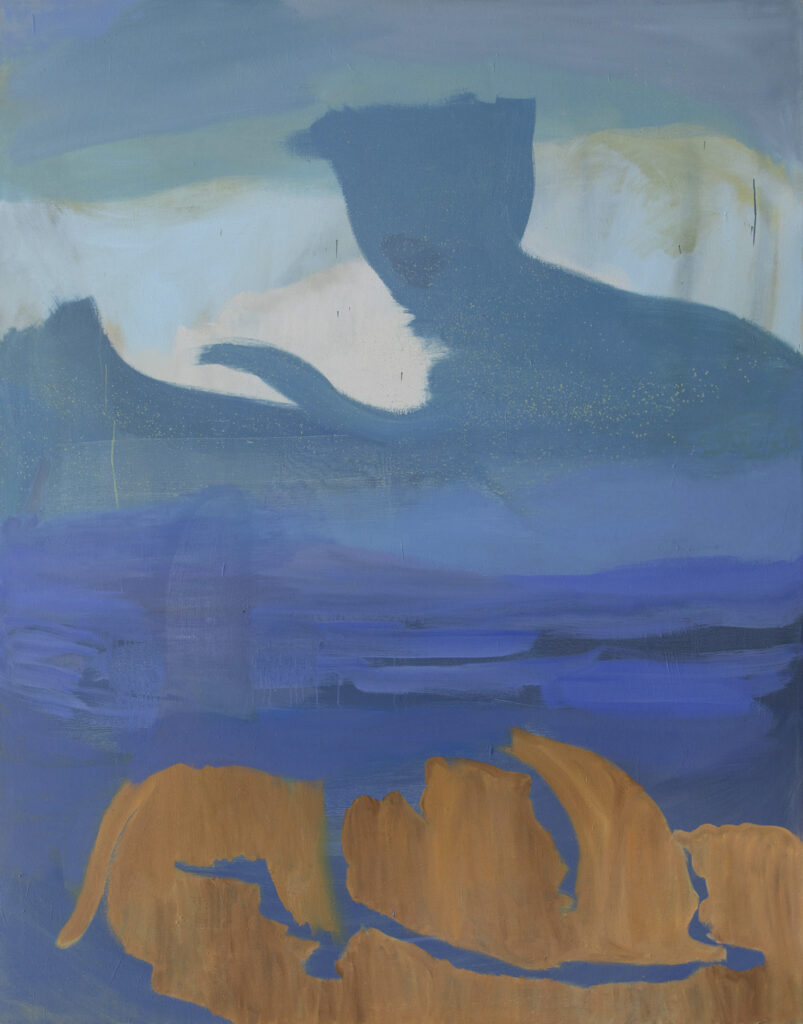
by Frizzi Krella
Vibrantly coloured mountains and gorges set in eruptive landscapes fill the expansive surfaces. Paint with all its intrinsic qualities is brought to the canvas, shaped and articulated, built up or spread thin, daubed or even allowed to run. Genesis and Apocalypse lie close together in the images created by Milko Pavlov.
Perhaps he is also showing us here a “second floor” of the Balkan Peninsula, as a psychiatric patient of his physician mother once put it during Pavlov’s childhood.
With sweeping gestures, Pavlov spreads the paint across the canvas; he paints big and thinks big, venturing with his pictures into a universe of the unfathomable, as if into infinity.
Real or surreal, Milko Pavlov sets out on a painterly search for clues, and not only in his colourful paintings; this is a search he already embarked on much earlier in monumental frottages, the first of which he produced on paper in the late 1990s during a fellowship in Worpswede.
Pavlov was fascinated as a child growing up in Bulgaria by the old wooden school benches from the era before the Second World War with all their notches, carvings and graffiti. He took to making rubbings of their surfaces on paper, as a kind of primal experience of the mimetic tracing of forms, a child’s game before he had ever heard of Max Ernst.
Of course it was Max Ernst who first conceptualized frottage and introduced it to art as an intensification of visionary faculties, a way “to get back to the picture through the back door”.
Realistic details were transformed in this way into surrealistic scenes. These two antithetical levels of reality are precisely what Pavlov brought to his sheets covered in graphite markings as he applied his large-format frottage principle.
In a process of additive rubbing over wire and wire mesh or nets spread on the floor, unique and complex pictorial systems emerged that unfurl an entire visual cosmos. Through multiple overdrawings and the superposition of identical structures, using graphite with varying degrees of hardness, so-called moiré effects are created that oscillate between light and shadow.
The potential offered by frottage is enormous and has allowed Pavlov to continue working with and exploring it for prolonged periods of time. It is this artistic experimentation that gave rise to the large frottages on canvas he produced in Berlin starting in 2008. By way of mimesis, the illustration of one reality bespeaks a new one. “This gives me a way to stand on my tiptoes and kiss the moon” – as Pavlov once poetically put it.
How are these frottages made? The artist spreads out the canvas on the floor of his studio, places rabbit wire, a form of wire mesh, underneath and starts rubbing over it, again and again, with great physical effort. The contours show up more distinctly on the canvas than the spaces in between. The structures condense and overlap, and amorphous organic forms grow into compositions that lack any logic or order.
“The frottages are peculiar extracts, drawn from object surfaces or areas saturated with their own history. The image in this instance is a peculiar blotter taking a print from an existence that has gone through complex temporal metamorphoses.”
In his frottages based on acheiropoetia, “icons made without human hands”, Pavlov composes by chance but not by chance, letting the head of Christ, known as the “Vera Icon”, emerge from the grey graphite. There are many icons that can serve here as models. In the early 1970s, the Icon Museum opened in the Alexander Nevsky Cathedral in Sofia, showing pictures of saints dating from the period between the 9th and 18th centuries.
Early on, Milko Pavlov already felt a greater affinity for Bulgaria’s icons than for Socialist Realism, except for the medical encyclopaedia with its fascinatingly realistic drawings that try to describe in detail the human body and organism. Apart from the medieval Orthodox icons, he was most impressed by the intensely colourful icons of the 18th-century Tryavna School. They glow in rich tones that can almost be called post-modern: from grey-pink to blue-red, in equally splendid gradations from dark to light. For Pavlov, they exercised an impact similar to the paintings of Gauguin, Bonnard, Matisse or Picasso – a mixture of pre-modern and post-modern.
Like his frottages, Pavlov’s colour paintings are also built up layer by layer. He applies the paint using myriad processes, sometimes including frottage, which he paints over with oil paint, washes out and paints over again, and then washes and paints over yet again. His pictures are hybrids of graphic art and painting. Human existence inscribes itself into this process of creation. Pavlov is in search of the invisible – or, as Paul Klee put it: Art is making the invisible visible. And yet abstraction itself is a form of the non-representable.
The archetypical forms of Christian icons, visible and invisible, thus also seem to emerge from his compositions: the Annunciation, the Entry of Jesus into Jerusalem, the Birth of Christ or the Transfiguration.
In parallel with his monumental paintings, Pavlov also produces powerful small-format overpainted photographs and evanescent watercolours. He takes as his point of departure private photographs, landscapes or icons, painting over them and then exposing certain sections again, allowing details to shine through by, for instance, combing across the surface to open up what was covered by paint. He uses the same techniques in his large paintings: grattage, imitation, the monotype.
In all of his images, which over time have grouped themselves as if of their own volition into series, Pavlov explores painting while also sounding out all the possibilities of frottage in connection with various techniques. “The colour knows everything,” he says, seeing himself as its apprentice. The most important issue that occupies him in relation to colour is the question of proportion. The right proportion – colour ratios are also proportions – must be arrived at anew in every picture. This gives rise to questions about their placement: light before dark or dark before light?
One of the formats Pavlov prefers using is 240 x 190 cm, whereby size is only a secondary factor. More important to the artist is that the picture should grow beyond its frame, appearing larger that it is. For him, a picture is successful if it looks like a fragment of a much larger whole.
The dates Pavlov sets to his works are fictitious and elude any linear concept of development, suggesting instead that we are approaching a point at which the future lies behind us. Therefore, the only frame of reference for Milko Pavlov’s pictures is Milko Pavlov’s pictures. “While Pavlov detaches his pictures from any historical context, he simultaneously positions them in a future one, reminding us that pictures in principle show something unreal.”
And yet Milko Pavlov’s pictures open up for us the great book of the universe, into which we can peer as if through windows. There is no beginning and there is no end.
